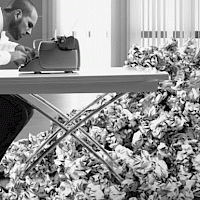I've bought a newspaper from the same shop for years now. Walking in, selecting the paper and taking it to the desk, handing over my money and waiting for the change. A begrudging thank you from the lady behind the till as I take the change is the first and only acknowledgement of my presence in the shop.
Contrast the news agent experience with my local HSBC branch. Upon entering the bank I am immediately confronted by a smartly dressed host, standing by a podium with the express purpose of making sure I am welcomed into the branch with a smile and a "hello". Granted, both the newsagents and the bank are places through which many anonymous customers pass, but as a regular customer of the former, you would expect that a more familiar and warm welcome would come from that experience than from the faceless multi-national bank.
Ordering a new car was a similar experience. Visiting my local dealership dressed in jeans and a t-shirt I was initially ignored. When the salesman did eventually engage me in conversation I was already feeling less than enthusiastic towards them and, to add to my negative feelings about the business, they then failed to telephone me with the promised finance information about the car I was considering. I’m sure they had dismissed me as a tyre-kicker the moment I walked in. Inevitably the car came from another supplier who couldn't have been more courteous and helpful – small plug here for Planet Leasing, Clarity’s preferred car leasing supplier.
Meeting and greeting is possibly the most important point of the customer interaction process. As part of Clarity’s sales training course, we spend a lot of time talking about the first point of contact that the customer has with the store. We believe that around 70% of the work done in forging a relationship with the customer is done within the first minute of their walking into the store.
There’s a lot to think about and potentially a lot of opportunity to make mistakes during this first minute. What if, for instance, you happen to be on the phone at the point someone walks in and there is no-one else in the shop to attend to the customer? Do you a) carry on your phone call and ignore them, b) scribble an ‘on the phone’ message on a pad and show it to them so they know what you’re doing, c) look up and gesture your acknowledgement of them, d) end your phone call and engage with the person in front of you? It’s a tough call and one which can make or break the relationship and hence the sale.
We all make snap judgements about people when we meet them. Is the person dressed like a tramp less or more likely than the guy in the suit to be able to afford a decent hi-fi system? I’ve found, as I mentioned with my car dealership experience, that the jeans and t-shirt often results in being ignored and if I happen to be wearing a suit and wander into a DIY store it is pretty well guaranteed that I will be asked where to find the lawn mowers, by someone who has assumed I’m management! It’s human nature to judge by appearances and there have been numerous examples of this shared during the sales course. One dealer revealed they have a regular tramp like customer who carries around £10K in cash in his Tesco carrier bag! A manufacturer mentioned the rough looking guy with the beer in one hand and the whisky in the other, who was so blown away by the demo that he took out a wad of rolled up notes to buy a state-of-the-art system there and then.
The simplest and most effective thing we can do when someone walks into our shops is to look up and smile. It’s a really small thing, but one that we have all seen fail to happen time and time again in a whole host of different retail environments. The first point of contact is an ice breaking moment - you have to do something to avoid the awkward silence that can occur when a customer walks in to the shop, particularly a customer who is new to the hi-fi shop environment. The member of staff is, quite simply, the face of the business and so if they get it wrong the business’s reputation is at risk. The snap judgement process works both ways - us about the customer and the customer about us.
The process of interaction between customers and the business is a subject about much has been written, perhaps most famously by Jan Carlzon, former CEO of the airline SAS. Carlzon reinvigorated a struggling state run airline through focus on customer service and embracing a concept called “moments of truth”. Originally coined by management theorist Richard Normann, the “moments of truth” theory states that “a service company’s overall performance is the sum of countless interactions between customers and employees that either help to retain a customer or send him to the competition.”
It’s a huge topic and one we may go into in more detail in a future blog, but for now why not take some time to do a basic analysis of the “moments of truth” that take place in your business. From the moment the customer first sees your advert; clicks on your website; speaks to you on the phone; sees the shop from across the street; opens the door; is greeted and offered a coffee. They all add up and paint a picture of the business in the customer’s mind and can ultimately determine whether they buy from you or not.







